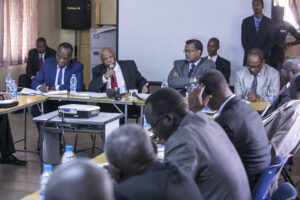Feasibility evaluation, a beacon of insight and foresight, guides us through the tumultuous seas of decision-making. It is a meticulous dance between ambition and reality, a testament to the dreams we dare to dream and the pragmatism that anchors us. In this exploration, we shall unravel the essence of feasibility evaluation, understanding its significance, the hands that craft it, and the labyrinth of challenges it presents.
Who Performs a Feasibility Evaluation?
The architects of a feasibility evaluation are varied, each bringing a unique brushstroke to the canvas. Project managers orchestrate the symphony, ensuring every note is perfect. Financial analysts, the guardians of fiscal prudence, assess the economic viability. Engineers and technical experts delve into the nitty-gritty, ensuring that the envisioned structure stands tall and robust. Market researchers, with their finger on the pulse of the market, provide invaluable insights into demand and competition. Often, organizations must decide whether to rely on their internal teams or to seek the wisdom of external consultants specializing in feasibility evaluation.
What is Feasibility Evaluation Services?
Feasibility services are the lighthouse in the foggy night, guiding projects to safe harbors. These services encompass:
- Preliminary Analysis: An initial sweep to gauge whether a detailed study is warranted.
- Technical Feasibility: Examining the technical resources and hurdles.
- Market Feasibility: Understanding market dynamics, demand, and competition.
- Financial Feasibility: Crafting cost-benefit analyses, financial projections, and funding requirements.
- Legal Feasibility: Navigating the legal landscape to ensure compliance and avoid pitfalls.
Explore more about feasibility study services in Uganda here.
How Long Does a Feasibility Evaluation Take?
The sands of time flow differently for each feasibility evaluation. Factors influencing the timeline include project size, data availability, and stakeholder involvement. Typically, this journey can span from a few weeks to several months. Patience and precision are your steadfast companions on this voyage.
Can a Feasibility Study Fail?
Indeed, the path of a feasibility evaluation is not without its shadows. Failure, in this context, means the revelation that a project is not viable. This stark conclusion may arise from unrealistic assumptions, inadequate data, bias, or unforeseen external conditions. But even in failure, there is wisdom to be gained, steering us away from doomed endeavors.
Who Should Conduct a Feasibility Evaluation?
The soul of a feasibility study lies in the expertise of its conductors. A team rich in industry knowledge, analytical prowess, technical expertise, and financial acumen is essential. Selecting the right team is akin to choosing the finest threads for a tapestry, ensuring the final weave is strong and beautiful.
How Many Participants for a Feasibility Study?
The chorus of voices in a feasibility evaluation must be diverse and representative. The number of participants can vary, but what remains constant is the need for a robust and inclusive sample. This ensures the evaluation’s findings are rich and reflective of reality.
Is Making a Feasibility Evaluation Hard?
The creation of a feasibility study is a journey fraught with challenges. Data collection can be arduous, resource constraints may press, and coordination can become a complex dance. Yet, with careful planning and the right expertise, these challenges are but stepping stones to success.
Is Feasibility Evaluation Confidential?
Confidentiality is the sacred vow of a feasibility study. Handling sensitive information with the utmost care is paramount. Confidentiality agreements, data security measures, and discretion are the pillars that uphold this vow, protecting proprietary information and competitive advantage.
What are the Risks of Feasibility Study?
The risks inherent in a feasibility evaluation are shadows that must be acknowledged. Inaccurate data, bias, cost overruns, and time delays are the specters that haunt this process. Mitigation strategies, including thorough planning and regular reviews, are the light that dispels these shadows.
How Do You Prove Feasibility of a Project?
Proving the feasibility of a project is a delicate art. It requires detailed analysis, robust data, clear documentation, and stakeholder buy-in. Each step, each piece of evidence, weaves together to form a tapestry that tells a compelling story of viability and promise.
Does Feasibility Evaluation Need Survey?
Surveys often play a pivotal role in feasibility evaluation. They are the bridges that connect the evaluators to the real-world sentiments and perspectives of potential users or stakeholders. Designing effective surveys, targeting relevant respondents, and gleaning actionable insights are essential to this process.
Conclusion
Feasibility evaluation is not merely a process but a journey—an odyssey through the realms of possibility and pragmatism. It is the beacon that illuminates our path, the compass that guides our decisions. Through understanding its essence, we are better equipped to navigate the complexities of project planning, steering our ships toward success.
FAQs
1. What Are the Key Steps in a Feasibility Evaluation?
- The voyage begins with preliminary analysis, followed by a detailed investigation, the crafting of a feasibility report, and culminates in informed decision-making.
2. How Much Does a Feasibility Evaluation Cost?
- The cost is as varied as the projects it assesses, influenced by scope, complexity, and the expertise required.
3. Can a Feasibility Evaluation be Conducted In-House?
- Yes, provided the organization has the requisite expertise and resources.
4. What Happens After a Feasibility Evaluation?
- The findings guide the decision: to proceed, to modify, or to abandon the project, each choice informed by the insights gained.
5. How Often Should Feasibility Evaluations be Updated?
- Regular updates are essential whenever significant changes occur in assumptions or the external environment.
In the end, a feasibility evaluation is our guiding star, a testament to our aspirations tempered by the wisdom of careful scrutiny. Explore more about the services that can guide your projects here. For additional insights, you can explore resources on project management and decision-making from trusted sources like Harvard Business Review and Project Management Institute.






